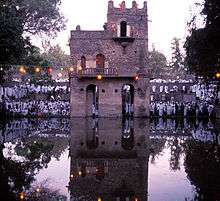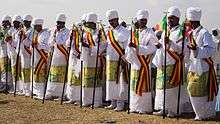Timkat
Timkat (Amharic: ጥምቀት T’imik’et, literally "Baptism"; also spelled Timqat) is the Orthodox Tewahedo celebration of Epiphany. It is celebrated on January 19th (or 20th in a leap year), corresponding to the 11th day of Terr in the Ethiopian calendar.

Timkat celebrates the baptism of Jesus in the River Jordan. This festival is best known for its ritual reenactment of baptism (similar to such reenactments performed by numerous Christian the Holy Land when they visit the Jordan).

During the ceremonies of Timkat, the Tabot, a model of the Ark of the Covenant, which is present on every Ethiopian altar (somewhat like the Western altar stone), is reverently wrapped in rich cloth and borne in procession on the head of the priest.[1] The Tabot, which is otherwise rarely seen by the laity, represents the manifestation of Jesus as the Messiah when he came to the Jordan for baptism. The Divine Liturgy is celebrated near a stream or pool early in the morning (around 2 a.m.). Then the nearby body of water is blessed towards dawn and sprinkled on the participants, some of whom enter the water and immerse themselves, symbolically renewing their baptismal vows. But the festival does not end there; Donald N. Levine describes a typical celebration of the early 1960s:
By noon on Timqat Day a large crowd has assembled at the ritual site, those who went home for a little sleep having returned, and the holy ark is escorted back to its church in colorful procession and festivities. The clergy, bearing robes and umbrellas of many hues, perform rollicking dances and songs; the elders march solemnly with their weapons, attended by middle-ages men singing a long-drawn, low-pitched haaa hooo; and the children run about with sticks and games. Dressed up in their finest, the women chatter excitedly on their one real day of freedom in the year. The young braves leap up and down in spirited dances, tirelessly repeating rhythmic songs. This celebration is also registered in UNESCO as an intangible heritage. When the holy ark has been safely restored to its dwelling-place, everyone goes home for feasting.[2]
UNESCO inscribed Timkat (Ethiopian Epiphany) in 2019 on the Representative List of the Intangible Cultural Heritage of Humanity.[3]
Notes
- Fuller, L.K. (2004). National Days/national Ways: Historical, Political, and Religious Celebrations Around the World. Praeger Publishers. p. 93. ISBN 9780275972707. Retrieved 2014-10-04.
- Levine, Donald N. (2014). Wax and Gold: Tradition and Innovation in Ethiopian Culture. University of Chicago Press. p. 63. ISBN 978-0-226-21544-0.
- "UNESCO - Ethiopian epiphany". ich.unesco.org. Retrieved 2020-01-02.
External links
| Wikimedia Commons has media related to Timkat. |
- "Timket" (PDF). 13 October 2004. Archived from the original (PDF) on 6 February 2012. Retrieved 2014-10-04.
- "Ethiopian Rift Valley Safaris - Timket - Epiphany in Ethiopia". ethiopianriftvalleysafaris.com. Archived from the original on 2014-09-29. Retrieved 2014-10-04.
- "meskelsquare.com". meskelsquare.com. Archived from the original on 2012-02-07. Retrieved 2014-10-04.
- Timkat Celebration in Lalibela